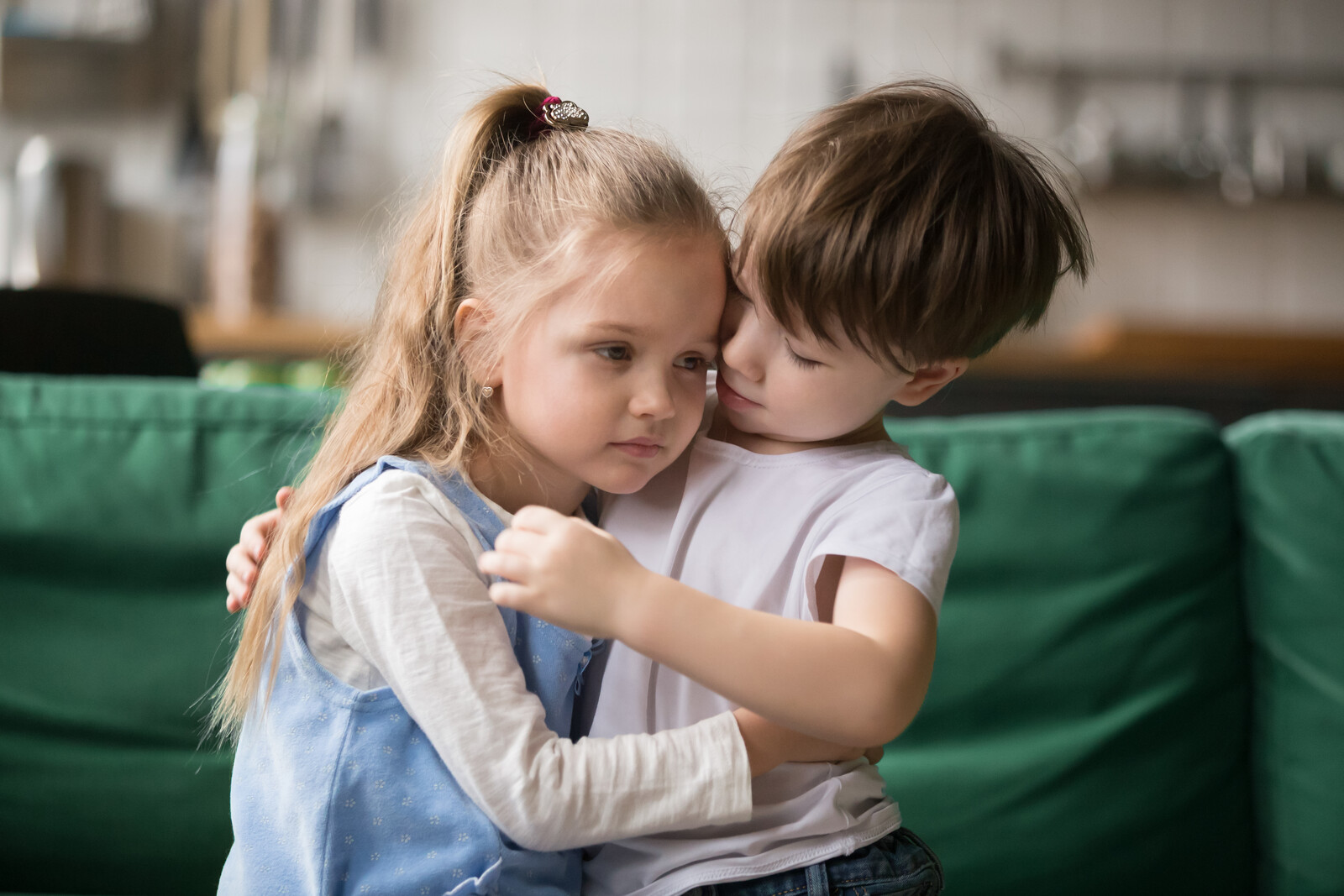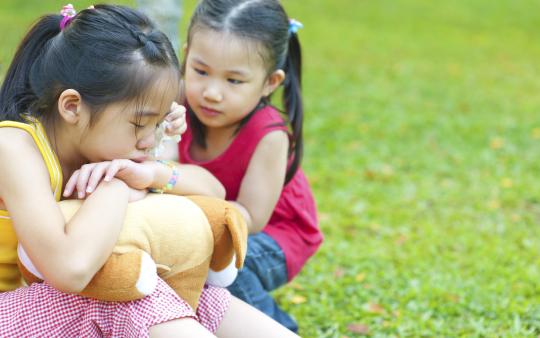“You need to say you’re sorry!” When problems or conflicts arise, adults and other children are quick to demand justice by insisting on an apology, pushing a child to take responsibility for their actions. However, what isn’t often considered is whether a forced sorry is helpful, especially as other kids are great barometers of sincerity and can sense when words of contrition are devoid of true caring. They will be the first to demand, “You need to say sorry like you mean it!” instinctively recognizing what we adults sometimes forget in the pursuit of justice: apologies must come from the heart. While we can force our children to say those words resentfully, we can’t make them feel appropriate remorse.
When we tell our children to say sorry without considering if there is genuine caring behind it, we make a mockery out of caring and encourage fake performances. Simply uttering the “right” caring word will not make a child more civil and socially responsible, but sincerely caring about others will help them grow in the right direction. If we want our children to have integrity and have their words match their feelings, then we should not tempt them to give hollow “caring” performances. Ultimately, when it comes to saying sorry, only meaningful encounters will do.
The meaning of caring
Caring is one of the most important human emotions, fueling healthy development and emotional maturity. It is at the very core of our concern for both ourselves and others. Caring is present in our desire to be conscientious in how we act and talk, and in how we feel responsible and act respectfully. It’s present in our desire to be interested and involved, to nurture and act non-violently despite being upset, and to be gracious and generous when mistakes are made. Without caring, human relationships do not work, and we are incapable of becoming more civil and mature. Caring is what tempers troublesome emotions, such as frustration and fear, because we care not to hurt another. When children feel their caring, they can self-actualize and bring their gifts into the world.
The good news is that caring is hardwired into the brain. Our well-being rests on attachment and connection with others, and as a species we crave togetherness because it offers us the best chance for psychological and physical survival. In short, we are better together. While we are born with the capacity to care, it requires support to be unlocked and expressed.
Attachment theory in parenting
It is attachment to things and people that unlocks caring emotions in a child. When we are attached, caring cements the relationship and makes contact and closeness work for each person. When adults build strong relationships with children, a child’s expression of caring will increase and deepen. To feel a vulnerable emotion like caring, we must first be cared for.
Attachment to a child can happen in many ways, but ideally develops over the first six years of life (although it is never too late to cultivate it!). Children will fall into attachment when a generous caretaker who is emotionally safe and engages with them in a meaningful way. As attachment forms, a natural desire will emerge to stay close, to feel a sense of belonging and loyalty, and to love back and feel safe enough to share their secrets. It is the invitation for a relationship from a caring adult that opens the child’s attachment instincts and the capacity to care deeply about others.
When you realize that caring is instinctive then it should be obvious that we don’t need to teach our children to care. You only need to watch a young child care for pets, siblings, and possessions to see how these innate emotions appear all on their own. If we want our children to be more caring, then we need to work at our relationship with them and let this caring unlock their instincts to care for others.
In addition to a safe attachment to a caregiver, for children to feel vulnerable emotions they also need soft hearts. When a child feels too unsafe, too alarmed, or too much separation, the brain can move to defend them from fully experiencing the vulnerability of the moment. These defences do not mean there is a problem with their brain, rather, it is a sacrifice play by the brain in order to preserve the functioning in the child.
To put it another way, if feeling emotion gets in the way of surviving, then the brain will suppress emotions that lead to too much upset and emotional overwhelm. This is the reason why the cry-it-out sleep training method (without adult comfort), seems to “work.” The child’s brain will simply shut down emotional distress when it is too much to bear, but it comes at the expense of the child’s caring and desire to be close.
How to navigate hurt feelings
How do you know if your child is caring? You will see it in the way they are kind to others or the way they desire to be close to you. Children who cannot feel their vulnerable emotions don’t talk about feeling sad or scared, indeed, they can seem flat and unaffected, or conversely, be aggressive and unyielding. If we see signs of a child not having caring emotions, then we need to reduce separation, alarm, and increase relational safety to bring back those vulnerable emotions. For example, this might mean helping a child who is struggling at school to feel more connected to their teacher by focusing on things they have in common. Relationships are the safe homes for a child’s soft heart.
To cultivate caring kids who take responsibility for their actions and words we need to lead them in making amends from a place of caring. When a sorry is needed, it is better to ask them, “Do you have any sorrys in you to give to this person?” This question directs the child’s attention to what they are feeling inside, rather than requiring them to perform as a person who is caring to avoid punishment. The goal is to anchor the child’s expression of caring to the emotion of caring. When emotion and expression are joined together, they form a powerful alliance that anchors the child so that they can do the right thing even if no one is watching. When their internal conscience and compass is built so that words match emotion, a child will naturally become more civil and socially appropriate.

Apologies and caring kids
The goal is to anchor the child’s expression of caring to the emotion of caring. When the two are joined together, they form a powerful alliance that anchors the child so that they can do the right thing, even if no one is watching.
If a child responds to the question of sorrys with a no, then the goal is to alert the child that a sorry is needed and when their sorrys “come back” then they are to deliver one. This can also happen in private so that the offended party’s immediate justice-seeking doesn’t thwart attempts for a genuine sorry. Allowing your child to play out their feelings, keeping them close and connected, are just some of the ways we can bide our time until the sorry eventually returns. When it does, we can then prompt the child to deliver it.
It is important to keep in mind that children under the age of seven can only process one emotion at a time. When they are full of frustration, they do not feel caring. Conversely, when they are full of caring, they will not feel any frustration. Patiently waiting and helping to move them through frustration may be required.
If a child’s sorry's don’t ever seem to come back, then the issue may possibly exist with some of the relationships they have, or that their heart isn’t soft in some circumstances. In either of these cases, take these as signs that more emotional support, a deepening of relationships, or softening of the heart is needed.
We cannot command a child to feel, as their emotions are unique to them and must come from within. However, we can lead a child to their caring feelings or facilitate their return by taking care of the child until they do. When we get our children to their feelings, then nature can do the rest, growing them into socially responsible and caring individuals.
You may also enjoy: How to Raise Truly Caring Kids, Conquering Children's Fears and Anxieties, and Helping Your Toddler Work through Anger.






